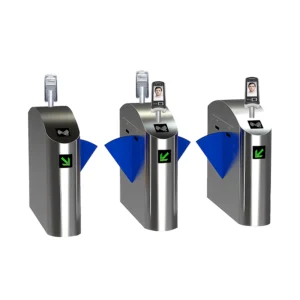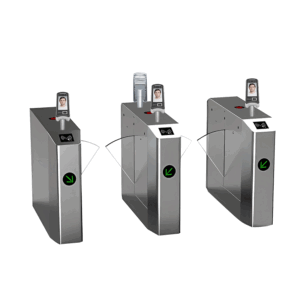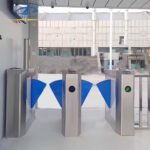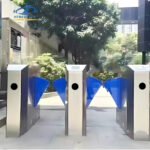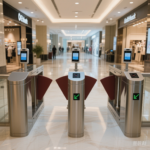In modern access control systems, flap barrier gates have become a popular choice for managing pedestrian traffic in secure areas. These gates are widely used in office buildings, train stations, airports, stadiums, and other high-traffic environments. But how does a flap barrier gate work, and why is it preferred over other types of turnstiles? This article explains the working principle, key features, and common applications of flap barrier gates.
What is a Flap Barrier Gate?
A flap barrier gate is an intelligent access control system designed to regulate pedestrian entry and exit in high‑traffic areas such as office buildings, metro stations, airports, and commercial complexes. It uses retractable flaps, usually made of acrylic or polycarbonate, which quickly open and close to allow or deny passage based on authentication methods like RFID cards, biometric recognition, QR codes, or mobile apps.
Flap barrier gates combine security, efficiency, and aesthetics, ensuring smooth pedestrian flow while preventing unauthorized access. They are widely used in modern facilities due to their fast response speed, durability, and integration capability with advanced security systems. In addition, they are highly adaptable for both indoor and semi‑outdoor environments, making them a preferred choice for smart building access control.
How Does a Flap Barrier Gate Work?
The working process of a flap barrier gate involves multiple coordinated steps to ensure secure, efficient, and controlled pedestrian access:
1. Authentication
When a person approaches the flap barrier gate, they must present a valid credential. This could include:
RFID access card — swiped or tapped on the card reader.
QR code — scanned via a built‑in reader or mobile phone.
Biometric recognition — such as facial recognition, fingerprint scanning, or palm vein authentication.
These authentication methods ensure that only authorized users can initiate the entry process.
2. Verification
Once the credential is presented, the access control system communicates with its internal database or an integrated server to verify the user’s identity.
If the credential matches an authorized profile, the system sends an “open” signal to the gate’s control board.
If the credential is invalid, expired, or blocked, the flaps remain closed, and an alert or warning may be triggered.
3. Flap Movement
After successful verification, the flaps — typically made from durable acrylic or polycarbonate — retract smoothly into the gate housing, creating a clear passage.
The flap movement is fast and silent, ensuring minimal waiting time for pedestrians.
The mechanism is designed for high‑traffic environments, allowing hundreds or even thousands of passages per day.
4. Passage Monitoring
Advanced infrared sensors or photoelectric detectors monitor the passageway in real time.
They detect the presence of a person, ensuring only one authorized entry per credential.
If someone attempts tailgating (following closely behind an authorized user) or entering from the opposite direction, the system can trigger an alarm, lock the flaps, or send a security alert to operators.
5. Automatic Reset
Once the user has fully passed through, the sensors confirm clearance, and the flaps automatically extend back to the closed position.
The system immediately resets, ready to process the next person.
In the event of a power outage or emergency evacuation, most flap barrier gates can automatically open for free passage to ensure safety.
Key Features of Flap Barrier Gates
Fast Throughput
Flap barrier gates are designed for high‑traffic environments, such as metro stations, corporate buildings, and event venues. With rapid flap retraction and closing speed, they can process 30–50 people per minute, reducing queues and preventing congestion during peak hours.
Multiple Authentication Modes
These gates support a variety of access verification methods to meet different security needs: RFID/IC cards for employees or registered members. Biometric systems like facial recognition, fingerprint scanning, and palm vein authentication. QR code and barcode scanning for visitor passes or event tickets. Mobile app or Bluetooth access for smart entry solutions.
Advanced Safety Mechanisms
Integrated infrared sensors and anti-pinch technology detect the presence of a person in the passageway, ensuring the flaps do not close prematurely. If an object or person is detected, the system automatically stops or reverses flap movement, preventing accidental injury.
Durable & Reliable Design
Made from 304 or 316 stainless steel with acrylic or polycarbonate flaps, these gates resist wear, corrosion, and deformation. The internal mechanism is engineered for millions of opening/closing cycles, ensuring long service life even in demanding environments.
Integration Capability
Flap barrier gates can be seamlessly integrated with access control systems, time attendance software, CCTV surveillance, and building management systems. This makes them ideal for organizations that require real-time monitoring, reporting, and security alerts.
Passage Monitoring & Anti-Tailgating
Equipped with multiple infrared sensors, the gates track every movement within the passage. They can detect tailgating attempts, unauthorized reversals, or forced entries, triggering alarms or sending alerts to security personnel. This feature enhances both security and operational efficiency.
Applications of Flap Barrier Gates
Corporate Buildings – Employee access management.
Public Transportation – Metro stations, bus terminals, and airports.
Event Venues – Concerts, stadiums, and exhibitions.
Educational Institutions – Campus security control.
Government Facilities – Secure entry for authorized personnel.
Advantages of Using Flap Barrier Gates
Efficient Flow Management – Handles large crowds without delay.
Enhanced Security – Prevents unauthorized entry and records passage data.
Customizable Operation – Adjustable opening speed, flap design, and integration options.
Disadvantages of Flap Barrier Gates
Higher Cost Compared to Tripod Turnstiles – Advanced features come with a higher price.
Requires Power Supply – Needs continuous electricity for operation.
Conclusion
Understanding how a flap barrier gate works helps businesses and facility managers choose the right access control solution. With its combination of speed, security, and flexibility, a flap barrier gate is an excellent choice for any location that requires efficient pedestrian management.
Frequently Asked Questions
Can flap barrier gates be customized for branding?
Yes. Many manufacturers offer customization options such as logo printing, LED lighting, and flap color to match your brand or facility design.
Do flap barrier gates support two-way traffic?
Yes. Most models can be configured for bi-directional use, allowing both entry and exit through the same lane.
What maintenance is required for a flap barrier gate?
Routine maintenance includes cleaning sensors, checking the motor and control boards, lubricating moving parts, and updating the control software.
How durable is a flap barrier gate?
With proper maintenance, high-quality flap barrier gates can last more than 8–10 years, even in high-traffic areas.
Can a flap barrier gate be integrated with visitor management systems?
Absolutely. It can be connected to visitor registration software to control and monitor guest access in real-time.
How secure is a flap barrier gate against tailgating?
Infrared sensors and alarm systems detect multiple entries on a single authorization, preventing tailgating and ensuring high security.

